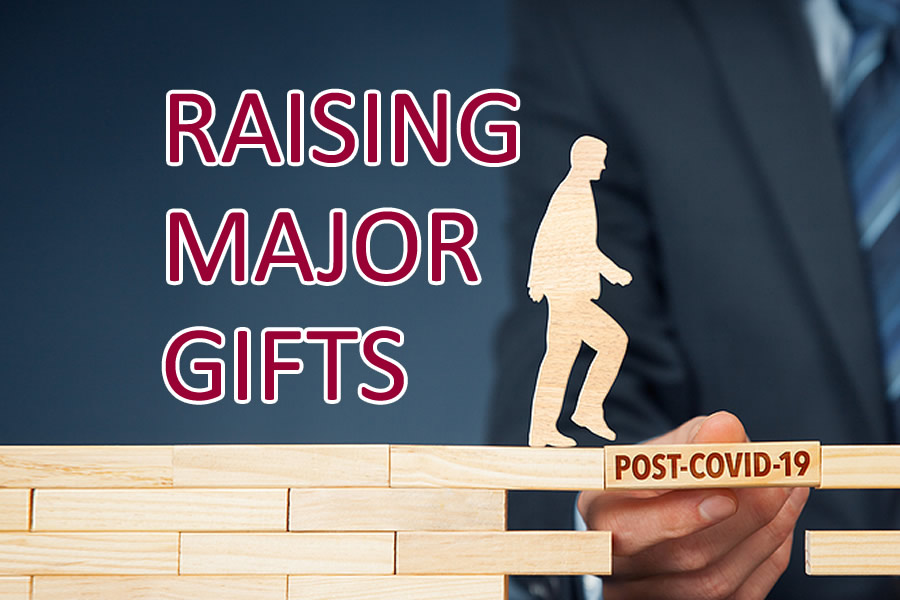
Over the years, I’ve written a lot about how to raise major gifts, but it’s been a long time since I’ve gotten back to basics.
As the pandemic is winds down, it’s helpful to consider how things have changed as we review the basics. With that in mind, here’s part one of a 4-part series on how to raise major gifts in a post-pandemic world.
What is a “Major Gift” Exactly?
When using the term “major gift” it’s important to define what we mean. For me, a major gift is any financial contribution asked for in-person or in a one-on-one, personal way.
Thanks to the pandemic, major gifts can be asked for virtually, over video chat, or even over the phone, but never as a group. When you sit down with someone (virtually or in person) and ask them for a specific dollar amount — that’s a major gift.
Major gifts are personal.
The reason I define a major gift as any personal, specific solicitation is because it’s unlikely you’d take the time to ask for a smaller gift in person. A smaller gift (for example, $100) is an amount you can probably raise with a mailing or email campaign. You wouldn’t need to solicit that kind of gift personally.
Think about it — if you were asked for a donation via mail, would you be as generous as possible? Maybe, but probably not.
Major gifts are relative.
Additionally, for a gift to truly be “major” it needs to make a difference to your organization. And it’s worth your time to ask an individual one-on-one.
Of course, a major gift to one person might be pocket change to another. Likewise, a major gift to one organization could be a common occurrence elsewhere. The size of your organization and the scope of your needs will help you determine how to define the size of a major gift at your organization.
Start With Your Top 20 Prospects
The first thing you need to do to raise major gifts is identify a realistic list of potential donors you could ask for money, in a personal and meaningful way.
To start, I recommend zeroing in on a small list of your top 20 prospective donors. A longer list often seems overwhelming and can cause analysis paralysis, whereby you might just put off asking for individual gifts indefinitely.
In other words, it’s better to ask 20 people from a small list than no one at all from a longer list. And if you get through your initial list of 20, you can always add more names.
Run lists from your donor database to find the largest and most loyal donors (those who give over and over). Once you have these donors identified (not including corporate or foundation donors) continue to narrow the list based on those with the biggest capacity (ability to make a major gift). You might know this if they give generously to other organizations in your community.
PRO-TIP — My rule of thumb is that your list is the right size if you are able to have individual, personal meetings (in-person or on Zoom) with each person at least 3 times per year — once to cultivate, once to ask, and once to say thank you.
So, if you have 20 people on your list, that’s 60 individual meetings per year. If you can manage more than that, great!
Comb Through Your Donor Database
The first place to start identifying potential major gift donors is in your donor database. Examine your existing list of donors and determine who could and might give more if they were asked in a personal way. In other words, start with your best potential donors:
- Your most generous donors
- Your most loyal donors
Those who are already giving generously and loyally are more likely than others (especially non-donors) to increase their giving.
Focus on current donors — not NEW donors.
Let’s say you received an appeal letter in the mail. The cause is one you care about. You write a check for $100 and mail it off. You feel good. You do this for a few years.
Then, someone from the organization approaches you and discusses what $1,000 would do for the organization. Would you consider it?
Yes!
Maybe you couldn’t give the full $1,000, but you would certainly give more than your usual $100 — probably much more.
PRO-TIP — Only when you’ve gone through all of your current donors should you look for new donors.
Honestly ask yourself:
Are we raising as much as possible from the people already giving to our organization?
If not, the people in your existing donor database is where you should focus your attention.
In the next post of this “Back to Basics” series, we’ll look at how to cultivate the donors on your list.

Excellent! Looking forward to the rest of the series.